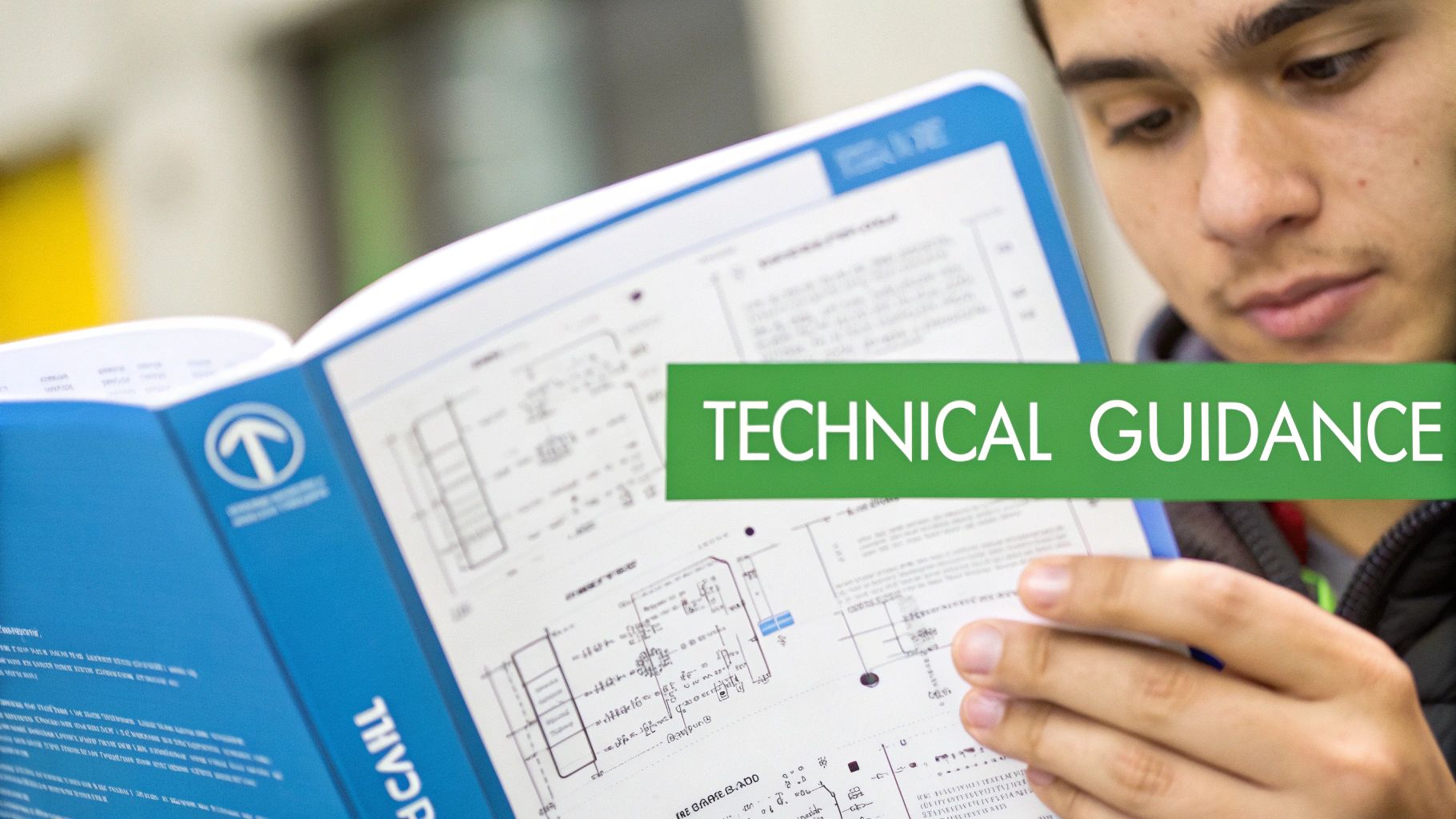Master technical communication with proven strategies that actually work. Learn from experienced technical writers and discover practical approaches to creating documentation that resonates with your audience.

Technical communication is about more than just explaining complex topics - it’s about strategically crafting information for specific audiences. When writing technical content, you need to carefully consider your language choices, use visual elements effectively, and select the right format to reach your readers. A software user manual requires a completely different approach than an engineering report. Understanding these audience differences is essential for communicating technical information successfully.
Creating high-quality technical content relies on several core principles that ensure information is accurate, accessible and useful for readers.
Technical communication has grown far beyond basic documentation. Today’s technical writers shape user experience, drive product adoption, and contribute directly to business success. They create content across many formats - from traditional guides to interactive tutorials and help systems. The field keeps growing as new tools and communication methods emerge. You might be interested in: How to master technical documentation.
As products and services become more complex, skilled technical communicators are more important than ever. They bridge the gap between technical experts and everyday users by translating complex concepts into clear, useful information. This ability to make technical details accessible and understandable directly impacts how successful a product will be with its users. The need for effective technical communication continues to grow as technology becomes more integrated into our daily lives.

Creating effective technical content today requires more than just understanding basic principles. The real challenge lies in applying those principles across different content formats that resonate with modern audiences. Each format serves a specific purpose and meets distinct user needs. Static documentation no longer suffices - technical communicators must now create engaging content that works across multiple channels and platforms.
Knowing your audience is essential for selecting the most effective content format. For instance, a developer working on API integration needs detailed technical specifications through clear API documentation or a structured knowledge base. In contrast, a non-technical user setting up the same software might learn better from step-by-step visual guides or video walkthroughs. The key is matching the format to how your audience prefers to consume information.
Context also plays a vital role in format selection. Someone quickly checking information on their phone might prefer short FAQ answers, while a user doing deep research at their desk could benefit more from an in-depth white paper. When you provide information in formats that match how people actually use it, they’re more likely to understand and apply it successfully.
Modern technical content comes in many forms, each serving different purposes:
While offering various content formats is important, keeping a consistent style across all of them builds trust and helps users navigate more easily. Using the same terms, tone, and branding across different formats creates a smooth experience for users moving between different types of content.
But creating good content is just the first step - you also need to know if it’s working. Looking at metrics like how long people spend reading pages, which content they view most, and what feedback they give shows what’s actually helping users. This data helps you improve your content strategy over time. By watching how users interact with different formats, you can keep adjusting your approach to better meet their needs.

Writing great technical content requires more than just understanding different formats - you need the right combination of skills and tools. Technical writers who excel at their craft blend deep technical knowledge with clear communication abilities. For example, when documenting a complex software feature, a writer needs to understand both the technical implementation details and how to explain them in terms that make sense to the end user.
To create effective technical content, writers need several key skills beyond technical expertise:
The right tools make a big difference in how efficiently you can create and manage documentation. This lets you focus more on writing quality content instead of administrative tasks. Here are some essential tools to consider:
As your documentation projects grow larger, having clear processes becomes even more important. Start by mapping out each step from initial research through final publication. This helps you stay organized and use your time well. Make sure to include regular review cycles to maintain quality and consistency. By continually improving your workflow based on what you learn from each project, you can keep your documentation process running smoothly even as complexity increases.

Technical communication has no borders. When writing technical content, we must ensure it resonates with readers worldwide, regardless of their native language or cultural background. Creating clear, accurate, and culturally-sensitive content requires specific skills and approaches. Let’s explore how to develop technical documentation that works effectively across different cultures and languages.
With billions of people accessing online content daily in countless languages, technical writers face unique challenges in reaching international audiences. A software manual, for instance, needs to make sense to users in Tokyo just as much as those in São Paulo. This means going beyond basic translation to truly understand how different cultures process and interpret information. Writers must consider how concepts, examples, and instructions translate across linguistic and cultural boundaries.
Making content work across multiple languages and cultures starts with smart planning from day one. Here are key approaches that successful technical writers use:
Quality control during localization requires careful attention to detail and the right partnerships.
Cultural differences shape how people interpret technical information. Some readers prefer direct instructions, while others respond better to a more diplomatic approach. Beyond culture, different countries have specific rules about language use and data privacy. Technical writers must stay current with these regulations to keep content compliant and effective.
By paying attention to these details, technical communicators create documentation that works well for diverse audiences. This careful approach helps build trust with users worldwide, improves their experience, and contributes to the success of products in global markets.
The field of technical communication blends writing skills with deep technical knowledge and expertise in user experience. From software documentation to medical writing, technical communicators work across many industries and formats to make complex information clear and accessible. As companies increasingly need to explain their products and services effectively, opportunities in this field continue to expand. Let’s explore what it takes to build a successful career in technical communication.
Technical communication offers many paths depending on your interests and strengths. As a technical writer, you might create user manuals that help people understand new software, write API documentation for developers, or develop white papers explaining complex technologies. If you enjoy focusing on digital experiences, you could work as a UX writer crafting the words users see in apps and websites. Other professionals choose to become instructional designers developing training materials, or medical writers creating healthcare documentation and patient resources. The variety means you can align your career with topics you find engaging while putting your communication skills to work.
Success in technical communication starts with demonstrating your capabilities through a strong portfolio. Include examples of your best work - whether that’s user guides, help documentation, or other technical content you’ve created. Getting involved in the technical communication community is equally important. Join professional organizations, attend industry events, and participate in online discussions. These connections often lead to mentoring relationships, collaboration opportunities, and job prospects as you advance in your career.
Clear writing forms the foundation, but technical communicators need several key abilities to succeed. Sharp analytical skills help you break down complex topics into clear, logical explanations. Picture explaining how to use a new smartphone feature to someone who has never used one before - you need to understand both the technology and your audience’s perspective. Being able to put yourself in your readers’ shoes helps you create content that truly meets their needs. The field also requires ongoing learning as new tools and platforms emerge. Staying curious and adaptable ensures you can grow along with changes in technology and communication methods.
According to the Bureau of Labor Statistics, technical writer employment is growing faster than average, with an 11 percent increase projected from 2016 to 2026. This reflects the ongoing need for professionals who can explain technical concepts clearly. While salaries vary by location, experience level, and specialty, the BLS reports that technical communicators earn competitive wages with room for growth. As you gain expertise, you can focus on high-demand areas like API documentation, UX writing, or medical writing. Building your skills strategically and staying current with industry trends positions you well for long-term success in this rewarding field.
As digital tools advance, technical communication is moving beyond traditional static manuals into more dynamic, interactive formats. Writers now create documentation using tools and methods that engage users in new ways - like hands-on tutorials that let people learn by doing rather than just reading. This fundamental shift means we need to look at technical communication through a fresh lens.
Several important technological developments are changing how technical communicators work:
While new tools offer exciting possibilities, technical communicators need to be thoughtful about which ones to adopt. Not every new technology will be the right fit. Here are key questions to consider:
Even as automation increases, skilled technical communicators remain essential. While AI can generate basic content, it can’t replace human judgment, empathy and creativity. Instead of being replaced, technical communicators are becoming strategic content designers who: